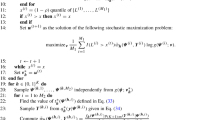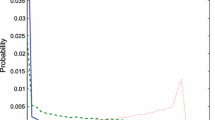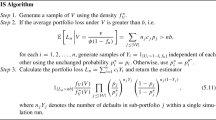Abstract
We consider the problem of calculating tail loss probability and conditional excess for the Bernoulli mixture model of credit risk. This is an important problem as all credit risk models proposed in literature can be represented as Bernoulli mixture models. Thus, we deviate from the efficient simulation of credit risk literature in that we propose an efficient simulation algorithm for this general Bernoulli mixture model in contrast to previous works that focus on specific credit risk models like CreditRisk\(^+\) or Credit Metrics. The algorithm we propose is a combination of stratification, importance sampling based on cross-entropy, and inner replications using the geometric shortcut method. We evaluate the efficiency of our general method considering three different examples: CreditRisk\(^+\) and two of the latent variable models, the Gaussian and the t-copula model. Numerical results suggest that the proposed general algorithm is more efficient than the benchmark methods for these specific models.

Similar content being viewed by others
References
Başoğlu, İ., & Hörmann, W. (2014). Efficient stratified sampling implementations in multiresponse simulation. In A. Tolk, S. Y. Diallo, I. O. Ryzhov, L. Yilmaz, S. Buckley, & J. A. Miller (Eds.), Proceedings of the 2014 winter simulation conference (pp. 757–768).
Başoğlu, İ., Hörmann, W., & Sak, H. (2013). Optimally stratified importance sampling for portfolio risk with multiple loss thresholds. Optimization, 62(11), 1451–1471.
Bassamboo, A., Juneja, S., & Zeevi, A. (2008). Portfolio credit risk with extremal dependence: Asymptotic analysis and efficient simulation. Operations Research, 56(3), 593–606.
Chan, J. C. C., & Kroese, D. P. (2010). Efficient estimation of large portfolio loss probabilities in t-copula models. European Journal of Operational Research, 205(2), 361–367.
Credit Suisse Financial Products. (1997). CreditRisk+: A CreditRisk management framework. London: Credit Suisse Financial Products.
Fishman, G. S. (1996). Monte Carlo: Concepts, algorithms, and applications. New York: Springer.
Frey, R., & McNeil, A. J. (2002). VaR and expected shortfall in portfolios of dependent credit risks: Conceptual and practical insights. Journal of Banking & Finance, 26, 1317–1334.
Geweke, J. (1989). Bayesian inference in econometric models using Monte Carlo integration. Econometrica, 57–6, 1317–1339.
Glasserman, P. (2004). Monte Carlo methods in financial engineering. New York: Springer.
Glasserman, P. (2005). Measuring marginal risk contributions in credit portfolios. Journal of Computational Finance, 9(2), 1–41.
Glasserman, P., & Li, J. (2003). Importance sampling for a mixed Poisson model of portfolio credit risk. In S. Chick, P. J. Sánchez, D. Ferrin, & D. J. Morrice (Eds.), Proceedings of the 2003 winter simulation conference (pp. 267–275).
Glasserman, P., & Li, J. (2005). Importance sampling for portfolio credit risk. Management Science, 51(11), 1643–1656.
Gupton, G. M., Finger, C. C., & Bhatia, M. (1997). Creditmetrics technical document. New York: J.P. Morgan & Co.
Kang, W., & Shahabuddin, P. (2005). Fast simulation for multifactor portfolio credit risk in the t-copula model. In M. E. Kuhl, N. M. Steiger, F. B. Armstrong, & J. A. Joines (Eds.), Proceedings of the 37th conference on winter simulation (pp. 1859–1868).
McNeil, A. J., Frey, R., & Embrechts, P. (2005). Quantitative risk management. New Jersey: Princeton University Press.
Rubinstein, R. Y., & Kroese, D. P. (2008). Simulation and the Monte Carlo method. New Jersey: Wiley.
Sak, H. (2010). Increasing the number of inner replications of multifactor portfolio credit risk simulation in the t-copula model. Monte Carlo Methods and Applications, 16, 361–377.
Sak, H., & Hörmann, W. (2012). Fast simulations in credit risk. Quantitative Finance, 12(10), 1557–1569.
Sak, H., Hörmann, W., & Leydold, J. (2010). Efficient risk simulations for linear asset portfolios in the t-copula model. European Journal of Operational Research, 202, 802–809.
Acknowledgments
This work was supported by The Scientific and Technological Research Council of Turkey (TÜB\(\dot{\mathrm{I}}\)TAK) Research Fund Project 111M108 and Xi’an Jiaotong- Liverpool University Research Fund Project RDF-14-01-33, and partially supported by Boğaziçi Scientific Research Fund Project 6923.
Author information
Authors and Affiliations
Corresponding author
Rights and permissions
About this article
Cite this article
Başoğlu, İ., Hörmann, W. & Sak, H. Efficient simulations for a Bernoulli mixture model of portfolio credit risk. Ann Oper Res 260, 113–128 (2018). https://doi.org/10.1007/s10479-016-2241-1
Published:
Issue Date:
DOI: https://doi.org/10.1007/s10479-016-2241-1




